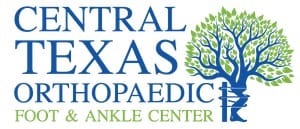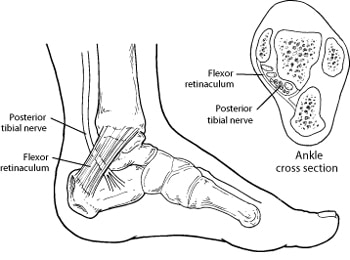Home » Uncategorized » What is Tarsal Tunnel Syndrome?
What is Tarsal Tunnel Syndrome?

You may be familiar with carpal tunnel syndrome, which causes aching pain and discomfort in the wrist, hand, and fingers due to things like overuse and/or lack of support. A similar ailment called tarsal tunnel syndrome can exist in our feet and toes.
Tarsal Tunnel Syndrome (also known as Posterior Tibial Neuroligia) has many of the same features as carpal tunnel syndrome but exists in the ankle, foot, and toes. The pain is caused by compression or damage to the tibial nerve. The tibial nerve runs through a narrow passageway inside your ankle called the tarsal tunnel and allows feeling and movement to parts of the foot.
What Causes Tibial Nerve Damage?
Damage to the tibial nerve is usually the result of consistent pressure due to things like bone spurs, cysts, nearby sprains, or injured tendons. Tibial nerve damage can also be a factor in other physically comprehensive medical issues like arthritis or diabetes. Other common causes include flat feet, high arches, varicose veins, and injuries that produce inflammation or swelling in and around the area of the tibial nerve. The resulting swelling or inflammation around the area of the nerve causes painful compression and damage to the tibial nerve.
What are the Symptoms of Tarsal Tunnel Syndrome?
- Sensations similar to an electric shock
- Numbness or tingling in the foot, ankle, toes, or leg
- Pain that is aggravated by physical activity
- Burning sensations
- Difficulty operating automobiles
- Feeling like the feet are not padded
This is not an exhaustive list of symptoms. While symptoms can vary from pain escalating over time (with or without activity) to sudden pain onset, the proper treatment can be the key to pain relief and symptom control.
How Is Tarsal Tunnel Syndrome Treated?
There are a few things that you can do to treat a compressed or damaged tibial nerve, including:
Reduce Swelling
Resting, icing, compression, and elevation – the R.I.C.E. method can help reduce swelling and inflammation. Over-the-counter anti-inflammatory medications (like nonsteroidal anti-inflammatory drugs – NSAIDs) can also help.
Therapeutic Support
Your doctor may prescribe braces or splits to limit movement that may compress the nerve. Custom-made orthotics can also be prescribed if your foot, heel, and arches need additional support.
Surgery
In rare cases, surgery may be recommended. A minimally invasive procedure to stretch out the ligament can be completed to reduce pain.
What to do if you are experiencing Symptoms?
If you’re experiencing any of the symptoms discussed, don’t hesitate to consult with an orthopedist. Orthopaedic surgeons will provide you with the most comprehensive care. They are best equipped to diagnose, treat and rehabilitate orthopedic conditions of the foot and ankle bones and tissue.
If you live in Central Texas, give CTX Foot and Ankle Center a call at 254-313-9559 or request an appointment online today with Dr. Bednarz. Together, you’ll create a treatment plan that is right for you.


